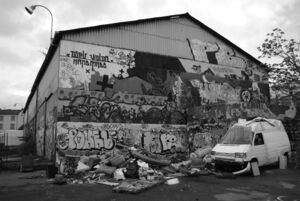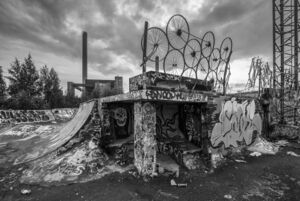Diy
diy
Originally, diy is a North American term for home improvement that has been in use since the 1950s.[1] Its close cousin is the French ‘bricolage’ both in its literal, everyday sense (‘bricolage’ hardware shops) and in its wider application in cultural anthropology and philosophy.[2] The literal meaning of diy is a material practice of someone without professional training, typically in makeshift or even crude ways.
Precursors to today’s diy culture include the nineteenth-century Arts and Crafts movement and its self-built communities, Dadaism in Berlin in the 1920s with its slogan ‘Dilettantes—rise up against art!’, counter-culture experiments in the 1960s and 1970s such as the Survival Scrapbooks of UK artist/musician/
activist Stefan Szczelkun that taught readers how to build their own shelter, grow their own food and generate their own energy, and the media activism of the Raindance Corporation artist collective that published diy instruction manuals for building one’s own radio and television broadcasting technology (critical making). These diy poetics were continued, among others, by the UK artists heath bunting and Kate Rich in the 1990s and in the contemporary zine series Self-Reliance Library of the Chicago-based Temporary Services collective.
Counter-cultural diy became commodified as early as in the 1970s with the Whole Earth Catalog,[3] an alternative lifestyle periodical and product catalogue. In the 1980s, the focus of its publishers shifted to home computing, early electronic social media and, ultimately, the Californian Internet economy.[4] Around the same time, punk and hip hop gave new meanings to diy. In punk, everyone could be their own fashion designer, a musician by playing only three guitar chords, and a graphic designer and publisher by making zines. Hip hop’s early music production technology of scratching vinyl records was born out
of poverty and diy improvisation.
These subcultures turned diy from merely a poetics
(in the literal sense of poiesis as ‘making’) into a simultaneous poetics, aesthetics and—to some degrees—ethos and politics.
diy since punk
As opposed to the more established terms ‘artist-run space’ and ‘artists collective/initiative’, contemporary ‘diy spaces’ (that exist particularly in the USA) imply no clear-cut separation between artists and non-artists, professionals and non-professionals, and include artists of all trades, musicians, community organizers, political activists, squatters, bohemians, artists and their audiences. ‘diy culture’ in this sense has the connotation of cultural work that can no longer be firmly placed under the moniker ‘art’, at least not fine art.[6]
Between the two extremes of diy as (a) counterculture and (b) home improvement stores there is the technological diy of hacker and ‘maker’ culture (critical making). With the boom of fab labs and maker spaces, this type of ‘diy’ has become its
own industry.
Diy culture becomes problematic as a term if one extends the perspective to non-Western and non-industrialized countries where self-making and makeshift improvisation is not an exception, but
the rule.
present
Subcultures and artist projects can converge in radical diy practices that are: self-taught, self-built, self-funded, happening in self-organized spaces using self-built infrastructure, with self-organized communication and distribution. ‘Self’ may refer to an individual, a collective or a community.
This makes diy a phenomenon that is concerned with autonomy. ‘Autonomy’, when translated literally from Greek to English, means ‘self-governance’. In the context of artists’ diy, autonomy is a poetics, and hence a categorically different notion of autonomy than that of aesthetic philosophy from Kant and Schiller to Adorno and Rancière. Instead of an idealist concept, autonomy becomes a material practice. Or perhaps more precisely: in diy culture, autonomy is being actively created—and permanently negotiated—in and through the material practice of its community members. Re-applied to art, this means, to quote David Teh’s characterization of ruangrupa, to further ‘autonomy of artists, singular or plural, but not necessarily that of the artwork’.[8]
Building upon an Arts and Crafts legacy, diy culture is typically based on an explicit or implicit critique of disembodied and alienated industrial or institutional production for which it creates hands-on alternatives. This critique and practice can have Marxist, left-anarchist, religious-spiritual, green-ecologist, conservative, liberal, libertarian, and extreme right-wing ideological underpinnings. Racist organic farmers, for example, neofascist squatters, Nazi rock bands, motorbike repair shops of outlaw biker clubs, religious cult communes and Alt-Right meme collectives are among those who practice and make up radical diy culture. This renders political-ethical claims for diy culture just as dubious as any other fundamental political-ethical claim for subculture,
let alone any romanticization of minorities on the pure grounds of their minority position.
- ↑ Garnet Hertz, ‘Two Terms: Critical Making + D.I.Y.’, conceptlab.com, 2020, conceptlab.com/2terms/pdf
/hertz-2terms-202011181901.pdf. - ↑ Such as the concepts of philosophical ‘bricolage’
by Jacques Derrida and Claude Lévi-Strauss. Jacques Derrida, Writing and Difference (Chicago: University of Chicago Press, 1978 [1967]). - ↑ Diedrich Diederichsen and Anselm Franke, The Whole Earth: California and the Disappearance of the Outside (Berlin: Sternberg Press, 2013).
- ↑ Fred Turner, From Counterculture to Cyberculture: Stewart Brand, the Whole Earth Network, and the Rise of Digital Utopianism (Chicago: University of Chicago Press, 2010).
- ↑ Such as, comprehensively, in Amy Spencer, DIY: The Rise of Lo-fi Culture (New York: Marion Boyars, 2005).
- ↑ Although, historically, many contemporary art careers grew out of diy collectives. Examples include Gordon Matta-Clark and the FOOD restaurant collective of the early 1970s and Sherry Levine and Jenny Holzer as members of New York’s Colab collective in the late 1970s to mid-1980s.
- ↑ David Teh, ‘Who Cares a Lot? Ruangrupa as Curatorship’, Afterall, 2012, afterall.org/article
/who-cares-a-lot-ruangrupa-as-curatorship. - ↑ Ibid.

